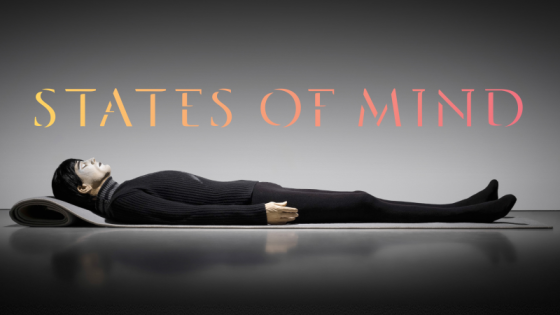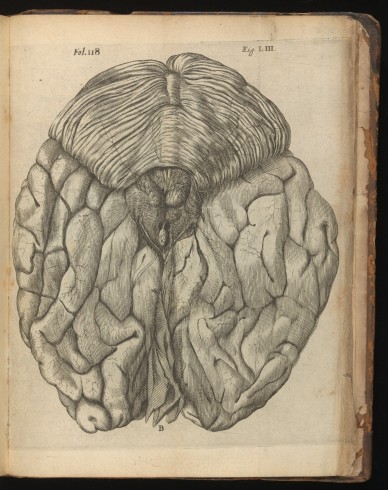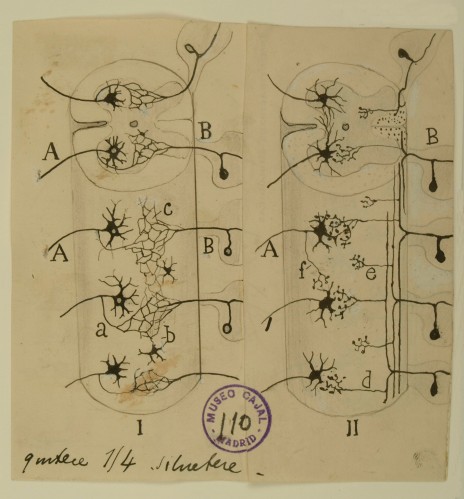
As a scientist, consciousness has always fascinated me. But understanding consciousness is not a project for science alone. Throughout history, philosophers, artists, storytellers, and musicians have all wondered about the apparent miracle of conscious awareness. Even today, while science might give us our best shot at figuring out the brain – the organ of experience – we need, more than ever, a melding of the arts and sciences, of contemporary and historical approaches, to understand what consciousness really is, to grasp what we mean by, as Mark Haddon eloquently puts it, “Life in the first person.”
This quote comes from Haddon’s beautiful introductory essay to a major new exhibition at the Wellcome Collection in London. Curated by Emily Sargent, States of Mind: Tracing the edges of consciousness “examines perspectives from artists, psychologists, philosophers and neuroscientists to interrogate our understanding of the conscious experience”. Its a fantastic exhibition, with style and substance, and I feel very fortunate to have been involved as an advisor from its early stages.
What’s so special about consciousness?
Consciousness is at once the most familiar and the most mysterious aspect of our existence. Conscious experiences define our lives, but the private, subjective, and what-it-is-likeness of these experiences seems to resist scientific enquiry. Somehow, within each our brains the combined activity of many billions of neurons, each one a tiny biological machine, is giving rise to a conscious experience. Your conscious experience: right here, right now, reading these words. How does this happen? Why is life in the first person?
In one sense, this seems like the kind of mystery ripe for explanation. Borrowing again from Mark Haddon, the raw material of consciousness is not squirreled away deep inside an atom, its not happening 14 billion years ago, and its not hiding out on the other side of the universe. It’s right here in front of – or rather behind – our eyes. Saying this, the brain is a remarkably complex object. It’s not so much the sheer number of neurons (though there about 90 billion). It’s the complexity of its wiring: there are so many connections, that if you counted one every second it would take you 3 million years to finish. Is it not possible that an object of such extraordinary complexity should be capable of extraordinary things?
People have been thinking about consciousness since they’ve been thinking at all. Hippocrates, the founder of modern medicine, said: “Men ought to know that from the brain, and from the brain only, arise our pleasures, joys, laughter and jests, as well as our sorrows, pains, griefs and tears … Madness comes from its moistness.” (Aristotle, by the way, got it wrong, thinking the brain hadn’t much to do with consciousness at all.)
Fast forward to Francis Crick, whose ‘astonishing hypothesis’ in the 1990s deliberately echoed Hippocrates: “You, your joys and your sorrows, your memories and your ambitions … and so on … are in fact no more than the behaviour of a vast assembly of nerve cells and their associated molecules”. Crick, who I was lucky enough to meet during my time in America, was working on the neurobiology of consciousness even on the day he died. You will see some of his personal notes, and his perplexing plasticine brain models, in States of Mind.

Descartes: view of posterior of brain, from De Hominem. Wellcome Collection
A major landmark in thinking about consciousness is of course Descartes, who in the 17th Century distinguished between “mind stuff” (res cogitans) and “matter stuff” (res extensa), so giving rise to the now infamous mind-body problem and the philosophy of dualism. Its a great thrill for to see an original copy of Descartes’ De Homine as part of this exhibition. Its modern incarnation as David Chalmers’ so-called ‘hard problem’ has recently gained enough cultural notoriety even to inspire a Tom Stoppard play (though for my money Alex Garland’s screenplay for Ex Machina is the more perspicuous). The idea of the hard problem is this: Even if we knew everything about how the operations of the brain give rise to perception, cognition, learning, and behaviour a problem would still remain: why and how any of this should be associated with consciousness at all? Why is life in the first person?
Defining consciousness
How to define consciousness? One simple definition is that for a conscious organism there is something it is like to be that organism. Or, one can simply say that consciousness is what disappears when we fall into a dreamless sleep, and what returns when we wake up or start dreaming. A bit more formally, for conscious organisms there exists a continuous (though interruptible) stream of conscious scenes – a phenomenal world – which has the character of being subjective and private. The material in States of Mind can help us encounter these ideas with a bit more clarity and force, by focusing on the edges – the liminal boundaries – of consciousness.
First there is conscious level: the difference between being awake and, let’s say, under general anaesthesia. Here, neuroscience now tells us that there is no single ‘generator’ of consciousness in the brain, rather, being consciousness depends on highly specific ways in which different parts of the brain speak to each other. Aya Ben Ron’s film of patients slipping away under anaesthesia is a beautiful exploration of this process, as is the whole section on ‘SLEEP | AWAKE’.
Then there is conscious content: what we are conscious of, when we are conscious. These are the perceptions, thoughts, and emotions that populate our ever-flowing stream of awareness. Here, current research is revealing that our perceptual world is not simply an internal picture of some external reality. Rather, conscious perception depends on the brain’s best guesses, or hypotheses, about the causes of sensory data. Perception is therefore a continuously creative act that is tightly bound up with imagination, so that our experience of the world is a kind of ‘controlled hallucination’, a fantasy that – usually, but not always – coincides with reality. The material on synaesthesia in States of Mind beautifully illuminates this process by showing how, for some of us, these perceptual fantasies can be very different – that we all have our own distinctive inner universes. You can even try training yourself to become a ‘synaesthete’ with a demo of some of our own research, developed for this exhibition. Many thanks to Dr. David Schwartzman of the Sackler Centre for making this happen.

Alphabet in Colour: Illustrating Vladimir Nabokov’s grapheme-colour synaesthesia, by Jean Holabird.
Finally there is conscious self – the specific experience of being me, or being you. While this might seem easy to take for granted, the experience of being a self requires explanation just as much as any other kind of experience. It too has its edges, its border regions. Here, research is revealing that conscious selfhood, though experienced as unified, can come apart in many different ways. For example, our experience of being and having a particular body can dissociate from our experience of being a person with name and a specific set of memories. Conscious selfhood, like all conscious perception, is therefore another controlled hallucination maintained by the brain. The section BEING | NOT BEING dramatically explores some of these issues, for example by looking at amnesia with Shona Illingworth, and with Adrian Owen’s seminal work on the possibility of consciousness even after severe brain injury.
This last example brings up an important point. Besides the allure of basic science, there are urgent practical motivations for studying consciousness. Neurological and psychiatric disorders are increasingly common and can often be understood as disturbances of conscious experience. Consciousness science promises new approaches and perhaps new treatments for these deeply destructive problems. Scoping out further boundary areas, studying the biology of consciousness can shed new light on awareness in newborn infants and in non-human animals, informing ethical debates in these areas. Above all, consciousness science carries the promise of understanding more about our place in nature. Following the tradition of Copernicus and Darwin, a biological account of conscious experience will help us see ourselves as part of, not apart from, the rest of the universe.

Santiago Ramon y Cajal, distinguishing the reticular theory (left) from the neuron doctrine (right). From the Instituto Cajal, Madrid.
Let’s finish by returning to this brilliant exhibition, States of Mind. What I found most remarkable are the objects that Emily Sargent has collected together. Whether its Descartes’ De Hominem, Ramon y Cajal’s delicate ink drawings of neurons, or Francis Crick’s notebooks and models, these objects bring home and render tangible the creativity and imagination which people have brought to bear in their struggle to understand consciousness, over hundreds of years. For me, this brings a new appreciation and wonder to our modern attempts to tackle this basic mystery of life. Emily Dickinson, my favourite poet of neuroscience, put it like this. “The brain is wider than the sky, for – put them side by side – the one the other will contain, with ease, and you – beside.”
States of Mind is at the Wellcome Collection in London from Feb 4th until October 16th 2016 and is curated by Emily Sargent. Sackler Centre researchers, in particular David Schwartzman and myself, helped out as scientific advisors. This text is lightly adapted from a speech I gave at the opening event on Feb 3rd 2016. Watch this space, and visit the exhibition website, for news about special events on consciousness that will happen throughout the year.
